| Rye %: | 90% |
| Stages: | Sourdough sponge, Scald, Scald-sponge (Opara), Yeast sponge, Final dough |
| Leaven: | Rye sour culture, Instant yeast |
| Start to Finish: | 24-30 hours |
| Hands-on Time: | 45-50 minutes |
| Yield: | One 3¼ lb/1.46 kg loaf |
My weakness for Baltic rye breads took over when I found this recipe in a Polish blog. Just to set the scene, Palanga is a coastal resort in western Lithuania, on the shores of the Baltic whose white sand beaches attract tourists from all over Europe, especially Poles and Germans. I suspect that this bread, which is lighter in both color and flavor that the other Baltic ryes I’ve encountered, is intended to appeal to the tastes of the town’s economically important summer visitors. Instead of the wholegrain rye flour that’s commonly used in Baltic breads, this one uses Type 1150, a much lighter blend that can be approximated by mixing 2/3 medium rye and 1/3 white rye.
Despite the lightness of the flour, the baking method is pure Baltic-Russian. a sour sponge, a scald that includes caraway and pale rye malt and a scald-sponge produce the sweet-sour flavor profile that’s typical of Baltic ryes, but with a lower level of intensity. A yeast sponge, meanwhile, opens and tenderizes the crumb, while a dry bake produces a thick, crisp crust that’s a delight to chew.
This is an exceedingly versatile bread that will go with pretty much anything savory: my own preference is for what I call “Baltic sushi” – a slab of lightly buttered rye, topped with herring and sliced red onion.
Sponge (Day 1, Morning):
| Ingredient |
Grams |
Ounces |
Baker’s |
| NYB Type 1150 light rye flour |
50 |
1.75 |
100% |
| Warm (105°F/41°C) water |
50 |
1.75 |
100% |
| Rye sour culture |
5 |
0.20 |
10% |
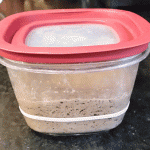 Combine the sponge ingredients, cover and ferment at room temperature (70°F/21°C) 8-10 hours. The sponge will be bubbly and will have doubled in volume.
Combine the sponge ingredients, cover and ferment at room temperature (70°F/21°C) 8-10 hours. The sponge will be bubbly and will have doubled in volume.
Scald (Day 1, Afternoon):
| Ingredient |
Grams |
Ounces |
Baker’s |
| NYB Type 1150 light rye flour |
290 |
10.25 |
100% |
| Pale rye malt, ground |
10 |
0.35 |
3% |
| Caraway seed |
2 |
0.05 |
1% |
| Hot (150°F/65°C) water |
400 |
14.10 |
138% |
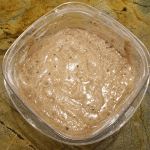 Combine the scald ingredients, cover and place in a warm (150°F/65°C) oven for 3 hours, then remove and let cool for 1 hour. The scald will have become very liquid and will have a strong sweet/malty aroma.
Combine the scald ingredients, cover and place in a warm (150°F/65°C) oven for 3 hours, then remove and let cool for 1 hour. The scald will have become very liquid and will have a strong sweet/malty aroma.
Opara (Day 1, Evening)
| Ingredient |
Grams |
Ounces |
Baker’s |
| Sponge |
105 |
3.75 |
100% |
| Scald |
702 |
24.75 |
669% |
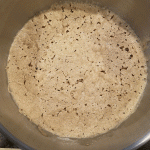 Combine the sponge and the scald in the mixer bowl, cover, and ferment at room temperature, 10-12 hours or overnight. The scald-sponge will be very bubbly and have a strong sweet-sour smell.
Combine the sponge and the scald in the mixer bowl, cover, and ferment at room temperature, 10-12 hours or overnight. The scald-sponge will be very bubbly and have a strong sweet-sour smell.
Yeast sponge (Day 2, Morning)
| Ingredient |
Grams |
Ounces |
Baker’s |
| NYB Type 1150 light rye flour |
150 |
5.30 |
100% |
| Warm (105°F/41°C) water |
150 |
5.30 |
100% |
| Instant yeast, ½ tsp | 2 |
0.05 |
1% |
Two hours before the scald-sponge matures, combine the yeast sponge in a separate container, cover and ferment at room temperature 2 hours. The sponge will have doubled and have a bubbled surface.
Final Dough (Day 2, Morning):
| Ingredient |
Grams |
Ounces |
| Scald-sponge |
807 |
28.50 |
| Yeast sponge |
302 |
10.65 |
| NYB Type 1150 light rye flour |
390 |
13.75 |
| Bread flour |
100 |
3.55 |
| Warm (105°F/41°C) water |
40 |
1.40 |
| Salt |
8 |
0.30 |
| Sugar |
20 |
0.70 |
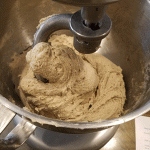 Combine the scald-sponge, yeast sponge and final dough ingredients in the mixer bowl and mix until thoroughly blended into a stiff dough that leaves the sides of the bowl, 4-5 minutes.
Combine the scald-sponge, yeast sponge and final dough ingredients in the mixer bowl and mix until thoroughly blended into a stiff dough that leaves the sides of the bowl, 4-5 minutes.
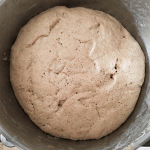 Cover the bowl and ferment at room temperature 1-2 hours, until the dough has doubled in volume and shows cracks or broken bubbles on the surface.
Cover the bowl and ferment at room temperature 1-2 hours, until the dough has doubled in volume and shows cracks or broken bubbles on the surface.
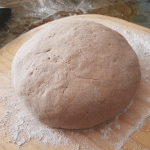 Turn the dough onto a lightly floured work surface and use wet hands to shape it into a boule or oblong.
Turn the dough onto a lightly floured work surface and use wet hands to shape it into a boule or oblong.
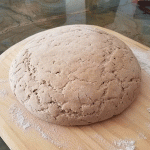 Place on a floured peel, if using a baking stone, or a parchment-lined sheet pan, cover and proof at room temperature until the loaf has visibly expanded and shows cracks or broken bubbles on the surface, about 1 hour.
Place on a floured peel, if using a baking stone, or a parchment-lined sheet pan, cover and proof at room temperature until the loaf has visibly expanded and shows cracks or broken bubbles on the surface, about 1 hour.
Preheat the oven to 450°F/230°C with the baking surface in the middle . Spray or brush the loaf with water and bake until the loaves thump when tapped with a finger and the internal temperature is at least 203°F/95°C, 60-70 minutes. Transfer to a rack, immediately brush the crust with boiling water, and cool thoroughly before slicing.
Baker’s Percentages
| Ingredient |
g |
% |
| TOTAL FLOUR |
990 |
100.00% |
| Type 1150 light rye flour |
880 |
88.89% |
| Bread flour |
100 |
10.10% |
| Malted rye |
10 |
1.01% |
| Water |
640 |
64.65% |
| Salt |
8 |
0.81% |
| Instant yeast |
2 |
0.20% |
| Rye sour culture |
5 |
0.51% |
| Sugar |
20 |
2.02% |
| Caraway seed |
2 |
0.20% |
| TOTAL FORMULA |
1,667 |
168.38% |
| % prefermented |
490 |
49.49% |



Britta
January 4, 2018Beautiful bread with an artistic presentation and a meticulous recipe. Thanks for posting. Britta at Castlerock Sourdough
Linda Teders
January 6, 2018Hi,
You list 20 gr sugar in your total ingredients, but I don’t see it in the recipe. I’m guessing it goes in with the yeast sponge?
kind regards
Linda
Stanley Ginsberg
January 6, 2018Sorry…. goes in the final dough. Correction made, and thanks for the sharp eyes.
Tortoise
January 10, 2018Hi Stan,
Can you give us an idea of approximately how long your final proof took at room temperature before popping into the oven? I’m planning on baking this delicious looking bread this weekend and need to draft a rough timeline.
Thanks,
Tortoise
Stanley Ginsberg
January 10, 2018About 1 hour at room temperature. Apologies for not including that. Recipe fixed
Jessica
January 11, 2018Thank you for the recipe! 🙂 will save this for my future bakes 🙂 I love Palanga’s rye, favourite from early childhood 🙂 <3 Thank you !
Pingback: Palanga Rye – Fornacalia
Stanley Ginsberg
January 20, 2018IMO, any diastatic malt will do, since its purpose is to provide the amylase enzymes that convert starches to sugars. The recipes that use rye malt do so because it appears in the original formulas. There may be slight flavor variations between breads made with rye malt vs. barley malt, but in general I think the two are interchangeable. Let us know how the bread turns out!
Heather
February 6, 2018May be a dumb question but where do I get the rye sour culture?
Stanley Ginsberg
February 11, 2018no dumb questions, only dumb answers. there are a zillion methods of creating your own sourdough starter online. just google “sourdough starter.” Instead of feeding it with wheat flour, use equal amounts by weight of rye flour and water.
Eliza
March 27, 2019I have a problem: in my home the room temperature is 26-27°C , I think I should shorten the time for each stage(except for the baking), but I don’t know with how much. Can you help me ?
Eliza
March 28, 2019What I should do differently if my room temperature in my kitchen is 26-27°C ?
Stanley Ginsberg
April 12, 2019Expect shorter fermentation and proofing times and adjust accordingly.
Marta
April 28, 2020Made this bread today and it was delicious. I`m fairly new to bread baking, so this was a bit challenging, but the result was spot on 🙂 Thank you very much. I`m from Latvia myself and my girlfriend is Lithuanian so we really enjoyed it.